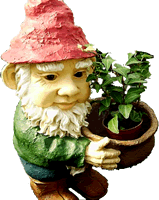How to Grow and Care for Plants in Pots and Planters
Just about any plant may be grown in a container throughout it's entire life. This is true whether the plant is classified as a house plant, a perennial, an annual, shrub or tree.

The Benefits of Planters
Growing your plants in containers provides you with a few options that are unavailable to permanent plantings. The ability to move the containers around is perhaps the biggest advantage. As the seasons and the sun's position changes, you can move your plant to a sunnier or shady spot to fit the cultural needs of the plant. You will also be able to move plants into the 'limelight' when they come into bloom, or into the background somewhere when they are finished. You will also be able to grow acid loving plants in an area of alkaline soil and vice versa.
Remember though, that when you are growing plants in pots or planters, that those plants are much more dependent on you to provide their necessities in life. They are in a limited amount of soil, with their roots restricted, and exposed to the elements far more than if they were field grown. It is important for the plant's health that pay close attention to watering and feeding requirements of the plant.
Watering your Plants
Plants in containers will dry out much sooner and need watering more often. To determine when the plant needs watering, stick your finger down into the soil and if is dry water the plant thoroughly. Because frequent watering will wash the plant food out of the soil, and the plant will utilize the limited soil nutrients they will be depleted much more rapidly, so a regular feeding program should be established according to the type of plant. During the growing season, either a slow release type plant food should be used or a soluble complete fertilizer should be used every two weeks. ALWAYS follow the manufacturers recommendations.
Choosing the Right Pot or Planter
Just about anything that will hold soil may be used as a planter. Ideally, the pot should have a diameter equal to 1/3 to 1/2 the height of the plant. Anything you use, though should have holes drilled in the bottom to allow the surplus water to drain away from the soil. The biggest cause of death to container grown plants is overwatering and consequent drowning. If it impossible to drill the holes you can add a layer of gravel below the soil, but watering must be monitored more closely. It may be more appropriate to put your plant into a regular pot and then place it inside your decorative planter. If you are building a planter using wood, use rot resistant wood such as redwood or cedar, and coat the inside with waterproof paint.
Choosing the Right Planting Mix
The choice of growing medium is extremely important. It must have the capability of holding water, but it must also be porous and drain easily. I prefer to use commercial potting mixes. There are many available, but they can vary a lot in quality, so be prepared to add organic materials such as compost or peat moss for moisture retention and course builders sand for drainage. The use of garden soil should be totally avoided because of the risk of insect infestations and soil borne diseases and fungi.
If you need a large quantity of mix and using bagged potting soil is cost prohibitive you can create your own mix. A good container mix should consist of one part of rich loam, one part course sand or perlite, and one part peat moss, compost, or other organic matter (bark, etc.) If you are growing acid loving plants such as Rhododendrons, Azaleas or Heathers the mix should contain two parts peat moss instead of one.